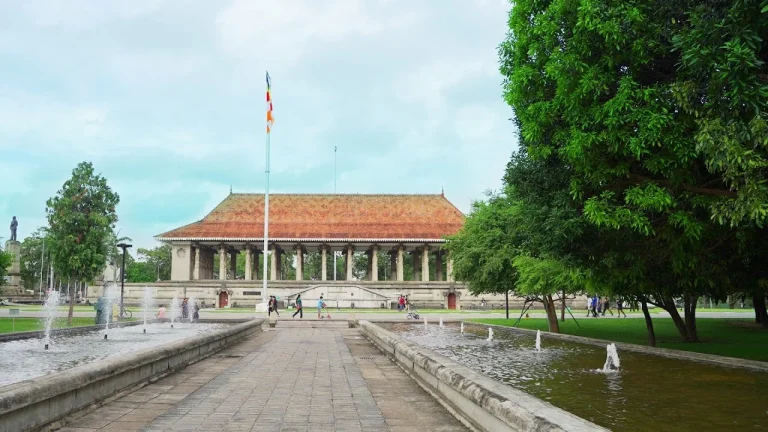All Provinces
Exploring the Colombo National Museum: A Journey Through Sri Lanka’s History and Culture
Nestled in the heart of Sri Lanka’s bustling capital, Colombo, lies a treasure trove of history and culture – the Colombo National Museum. This grand museum, also known as the Sri Lanka National Museum, is the largest and most prestigious museum in the country. It offers a fascinating insight into the island’s rich history, from ancient times to the colonial era and beyond. If you’re planning a visit to Colombo, this museum is a must-see for anyone interested in Sri Lanka’s unique heritage.
A Glimpse into the Past
The Colombo National Museum, established in 1877, is one of the oldest and most significant cultural institutions in Sri Lanka. It was founded by Sir William Henry Gregory, then British Governor of Ceylon, who recognized the need to preserve and showcase the rich historical and cultural artifacts of the island. Today, the museum continues to serve as a window into Sri Lanka’s past, housing an extensive collection of artifacts that span over two millennia.
The building itself is a masterpiece of neo-classical architecture, with its pristine white facade, large columns, and elegant design that reflect the grandeur of British colonial rule. As you approach the museum, you are immediately struck by the stately structure that stands amidst lush greenery, offering a peaceful escape from the urban sprawl.


What to Expect Inside
The museum’s ground floor focuses on ancient Sri Lanka, with exhibits featuring artifacts from the Anuradhapura and Polonnaruwa kingdoms, which date back to as early as the 4th century BCE. One of the highlights here is the magnificent royal throne of King Wimaladharmasuriya II, which dates to the 17th century. Decorated with intricate carvings, this golden throne is a symbol of the island’s royal history.
As you continue your journey through the museum, you’ll encounter a vast array of Buddhist relics, including ancient statues of the Buddha in various postures. The Buddha statues from Anuradhapura and Polonnaruwa are particularly impressive, as they display the evolution of Sri Lankan art and culture during these ancient periods.
The museum also houses numerous exhibits on Sri Lanka’s traditional arts and crafts, including ancient manuscripts written on palm leaves, beautifully carved wooden furniture, and traditional masks used in Sri Lankan dance and rituals. These exhibits offer a glimpse into the island’s spiritual and cultural life, showcasing the importance of religion and artistry in Sri Lankan society.
Highlights of the Museum
- The Stone Buddha Statues: Among the most famous pieces in the museum’s collection are the ancient stone statues of the Buddha, which are beautifully crafted and display the serenity and grace associated with traditional Buddhist sculpture. Some of these statues are over 1,500 years old and are remarkable examples of Sri Lanka’s sculptural artistry.
- The Crown Jewels and Royal Regalia: The museum’s crown jewel collection offers an impressive display of gems and precious stones, including items worn by Sri Lanka’s ancient monarchs. These stunning pieces, adorned with sapphires, rubies, and gold, reveal the island’s long-standing tradition of gem craftsmanship.
- Traditional Masks: One of the museum’s unique exhibits is its collection of traditional masks, which are used in Sri Lankan cultural rituals and theatrical performances. These masks, often depicting gods, demons, and animals, are colorful and intricately designed, each telling a story from Sri Lankan mythology.
- Ancient Coins and Currency: The numismatic collection is another must-see, offering visitors a chance to see the coins used throughout Sri Lanka’s history, including those from the Anuradhapura, Polonnaruwa, and Kandyan periods, as well as coins from European colonists.
The Colonial Era Exhibits
As you move to the upper floors, the museum shifts focus to more recent history, specifically the colonial period. This section showcases Sri Lanka’s interactions with the Portuguese, Dutch, and British, who colonized the island at different times. Items such as colonial-era furniture, paintings, and military artifacts offer insight into how European influence shaped the island’s modern history. A prominent feature in this section is a large collection of Dutch porcelain and ceramics, reflecting the significant trade links established between Sri Lanka and the European powers.







The Museum Garden
Don’t forget to spend some time exploring the museum’s garden, which is an attraction in itself. Surrounded by lush trees and well-maintained lawns, the garden offers a serene atmosphere, perfect for unwinding after your museum tour. There is also a charming museum café where visitors can enjoy refreshments while soaking in the peaceful surroundings.
Practical Information for Visitors
- Location: The Colombo National Museum is located at Sir Marcus Fernando Mawatha, in Colombo 7, one of the most prominent areas in the city.
- Opening Hours: The museum is open daily from 9:00 AM to 5:00 PM, except on public holidays such as Poya days (Buddhist full moon holidays).
- Ticket Prices: Tickets are reasonably priced, with different rates for local and international visitors. Students and children often get discounted rates. Make sure to check the updated pricing on the museum’s official website or inquire at the entrance.
- Guided Tours: For a deeper understanding of the exhibits, it’s highly recommended to join a guided tour, which is available in both English and Sinhala. These tours offer detailed explanations of the key artifacts and provide context for the museum’s vast collection.
Final Thoughts
A visit to the Colombo National Museum is more than just a walk through history; it’s a journey into the heart of Sri Lanka’s cultural and spiritual heritage. From its ancient Buddhist relics to its colonial artifacts, the museum tells the story of an island that has been shaped by a diverse range of influences, both local and foreign. Whether you’re a history buff, an art lover, or simply curious about Sri Lanka, this museum provides a comprehensive and immersive experience that will leave you with a deeper appreciation for the island’s rich past.
Make sure to set aside a few hours to explore the museum thoroughly and immerse yourself in the fascinating world of Sri Lanka’s history. After your visit, you’ll leave with a newfound respect for the cultural tapestry that makes this island nation so unique.
See More Tourist Places Click Here









